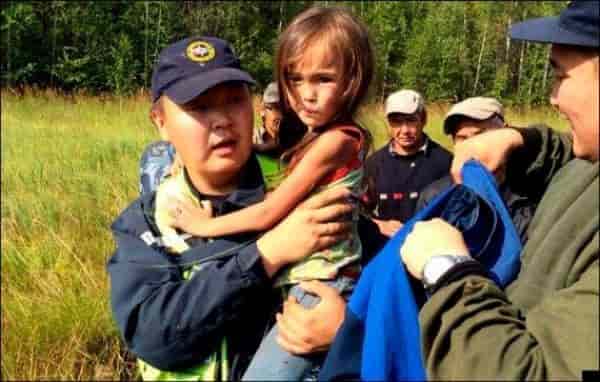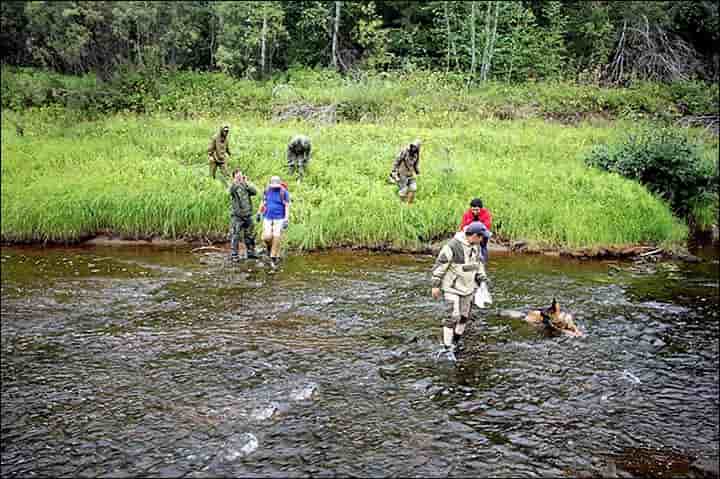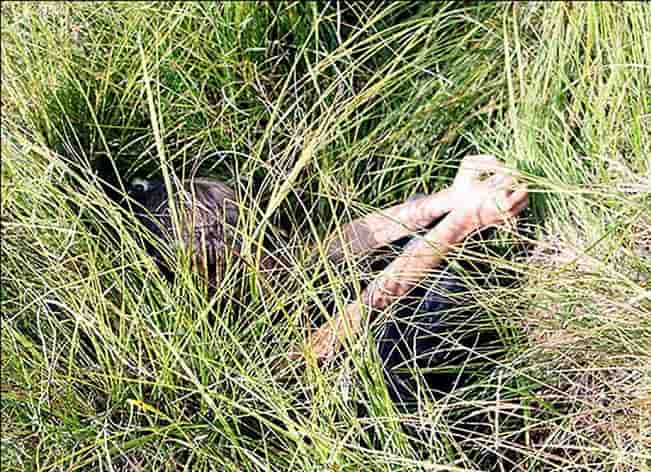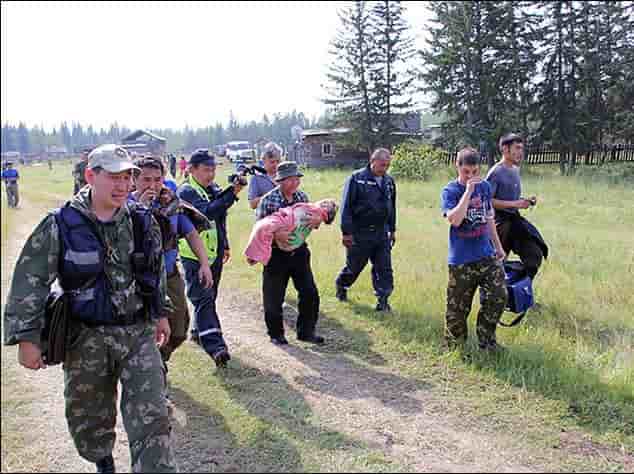Karina Chikitova, Russian’s Real Live MOWGLI

The story of Karina Chikitova is a tale of extraordinary survival, resilience, and the unbreakable bond between a child and her dog.
In July 2014, 3-year-old Karina Chikitova from the remote Sakha Republic in Siberia, Russia, went missing and survived alone in the harsh wilderness for 11 days, with only her loyal dog by her side. This heartwarming and incredible story of survival captured the world’s attention and remains a testament to the power of hope, instinct, and nature.
The Journey Begins: How Karina Got Lost
Karina Chikitova lived in the small village of Olom, nestled in the vast, rugged terrains of Siberia. On July 29, 2014, she decided to follow her father, Rodion Chikitov, who was setting out on a trip to his native village. Without anyone realizing it, Karina, along with her beloved dog Naida, wandered into the Siberian taiga, one of the most inhospitable forests on the planet. Her father, unaware that Karina was following him, continued his journey.
Karina’s mother, Talina Chikitova, only realized her daughter was missing several days later, believing initially that Karina was with her father. Upon discovering that Karina was not with him, a frantic search ensued. The reality was terrifying—the Siberian taiga is known for its predators, including bears and wolves, as well as its dense, disorienting landscape, making survival difficult even for adults.
The Siberian Taiga: A Hostile Environment
The Siberian wilderness, or “taiga,” where Karina was lost, is one of the largest forest regions in the world, known for its severe weather conditions, dense forests, and wildlife dangers. The summer months in this region are short, and although the days can be warm, the nights turn cold. The forest is full of predators like wolves and bears, making it an incredibly dangerous place for anyone, let alone a 3-year-old girl.
Survival in such an environment requires shelter, food, water, and the ability to navigate the wild—a challenge for someone so young. However, Karina had something very special on her side: her dog, Naida.
Eleven Days in the Wilderness: How Karina Survived
For 11 days, Karina Chikitova wandered the forest, surviving against all odds. Her diet during this time consisted mainly of berries and river water. The natural instincts of Naida, her loyal dog, played a crucial role in her survival. Naida stayed with Karina, offering her companionship, warmth, and protection from predators.
At night, Karina and Naida huddled together for warmth. While the days were warm, the temperature dropped significantly at night. Naida’s presence likely helped keep Karina’s spirits high and provided the physical warmth necessary to survive the cold Siberian nights.
The child’s resourcefulness also played a critical role in her survival. She sought shelter in tall grass to hide from predators and avoided dangerous animals. This ability to find refuge and remain hidden in the vast expanse of the taiga speaks volumes about Karina’s instincts, even at such a young age.
The Role of Naida: A Heroic Dog’s Contribution
One of the most remarkable aspects of Karina’s story is the role her dog Naida played. After days of searching for food and walking through the wilderness with Karina, Naida eventually left the child’s side and returned to the village. At first, villagers were devastated, fearing that Naida’s return without Karina meant that she had not survived. But Naida’s return gave rescuers a vital clue: Karina was still alive and likely in the same area where Naida had been.
Using Naida’s return as a starting point, search and rescue teams intensified their efforts, focusing on the region where the dog had come from. Naida, by instinct, had returned to bring help to her young owner, proving to be the hero of this heart-stopping ordeal.
The Rescue: A Miracle in the Taiga
After days of relentless searching, a rescue team finally found Karina on August 11, 2014, more than a week after she had gone missing. She was discovered lying in tall grass, weak but alive, with bare feet covered in cuts and bruises, and her body visibly affected by malnutrition. Despite the dangers and challenges she faced, Karina was conscious and immediately recognized by rescuers.

The rescue was nothing short of miraculous. Rescuers were overjoyed to find her alive, as the odds had been stacked heavily against her. With her small body having endured 11 days without adequate food and water, Karina was quickly flown to a hospital in Yakutsk, where she was treated for exhaustion, dehydration, and hypothermia.

Despite the traumatic experience, Karina’s recovery was remarkable. She was soon reunited with her family, including her father, who had been devastated by her disappearance. Her survival story spread like wildfire, capturing the hearts of people worldwide.

The Aftermath: Karina’s Remarkable Strength
Karina’s story is not just about survival; it is about strength, resilience, and the power of hope. After her recovery, Karina became a symbol of bravery and perseverance. The people of Sakha, and many around the world, hailed her as a living miracle.

In honor of her survival, a statue of Karina and Naida was erected in the capital city of Yakutsk, symbolizing their incredible bond and the strength they showed during those harrowing 11 days. This story continues to inspire people around the world, showing that even in the most hopeless of situations, there is always a chance for survival.
A Story of Survival and Hope
The tale of Karina Chikitova’s survival in the unforgiving Siberian wilderness is one of the most extraordinary stories of human resilience and the enduring bond between a child and her dog. Against all odds, Karina survived for 11 days, navigating the challenges of the wilderness with little more than instinct and the loyalty of her dog.
Her story reminds us of the strength of the human spirit and how, even in the most adverse conditions, hope and perseverance can carry us through. Karina Chikitova’s survival will forever remain a powerful narrative of hope, resilience, and the unyielding bond between humans and their animal companions.
FAQ: Karina Chikitova’s Survival Story
1. Who is Karina Chikitova?
Karina Chikitova is a young girl from the Sakha Republic in Siberia, Russia, who gained worldwide attention in 2014 after she survived alone in the Siberian wilderness for 11 days at the age of 4.
2. How did Karina Chikitova get lost in the forest?
Karina wandered into the Siberian taiga after following her father, who was unaware that she was behind him. She and her dog, Naida, got lost in the vast forest without anyone knowing.
3. How did Karina survive in the wilderness for 11 days?
Karina survived by eating wild berries and drinking water from streams. She sought shelter in tall grass to protect herself from predators, and her dog Naida provided warmth and companionship during the cold Siberian nights.
4. What role did Karina’s dog, Naida, play in her survival?
Naida stayed with Karina throughout most of the 11 days, protecting her from predators and providing warmth during the nights. After 9 days, Naida returned to the village, which helped lead rescuers to the area where Karina was found.
5. What is the name of Karina Chikitova’s dog?
Karina’s loyal dog is named Naida, and it played a crucial role in helping her survive the ordeal.
6. What type of dog is Naida?
Naida is a mixed-breed dog, common in Siberian villages. Though not a specific breed, these dogs are known for their resilience and ability to survive in harsh environments like the Siberian wilderness.
7. How did rescuers find Karina?
After Naida returned to the village, rescuers intensified their search in the area where the dog had come from. On the 11th day, they found Karina lying in tall grass, weak but alive.
8. What were the conditions like in the Siberian taiga?
The Siberian taiga is known for its harsh environment. While summer days can be warm, the nights get very cold. The forest is home to dangerous predators such as wolves and bears, making survival extremely difficult.
9. How was Karina’s condition when she was found?
Karina was weak, dehydrated, and had cuts and bruises on her feet, but she was alive. She was flown to a hospital for immediate treatment, where she recovered from exhaustion and malnutrition.
10. How long did it take for Karina to recover?
Karina made a remarkable recovery in the hospital despite her ordeal. She was soon reunited with her family and returned to normal life with no lasting physical injuries.
11. What happened after Karina’s rescue?
Karina became a symbol of hope and survival. A statue of Karina and Naida was erected in Yakutsk, the capital of the Sakha Republic, to commemorate their incredible bond and her survival story.
12. What is the significance of Karina Chikitova’s story?
Karina’s story is a testament to the power of human resilience, instinct, and the bond between humans and animals. Her survival against the odds continues to inspire people worldwide.
13. Is there a statue of Karina Chikitova?
Yes, a statue of Karina and her dog Naida was erected in Yakutsk, Russia, as a tribute to her miraculous survival and the loyalty of her dog.
14. What lessons can be learned from Karina’s story?
Karina’s story teaches us the importance of hope, perseverance, and the incredible strength of the human spirit. It also highlights the bond between humans and animals, as Naida played a crucial role in her survival.
15. Are there any other examples of similar survival stories?
While Karina’s story is unique, there are other survival stories that showcase the resilience of the human spirit, especially involving children and animals. However, Karina’s survival in the harsh Siberian taiga at such a young age makes her story particularly extraordinary.
16. How did the world react to Karina’s survival?
Karina’s survival captured global attention, with people around the world expressing amazement at her resilience. Her story was widely covered in the media, and she became an inspiration to many.
